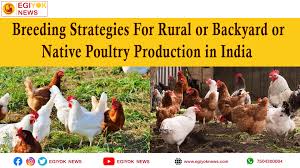IMPORTANCE OF CONSERVATION OF INDIGENOUS BREEDS OF LIVESTOCK AND POULTRY
Neha Kumari
Internee Student, VC&RI, Namakkal, TANUVAS
Email: sujatakumari24124@gmail.com
Abstract: India being an agricultural country, livestock and poultry contributes to employment and income to rural areas. Nowadays, indiscriminate breeding and improper management has resulted in decline of native breeds. Despite of many superior qualities, these native breeds is losing its existence. Thus, there is a need of conserving these indigenous breeds before it’s too late.
Introduction: Livestock (lively+stock) provides livelihood to 2/3rd of rural community. India being the global agricultural powerhouse. It’s world’s largest producer of milk, pulses and spices. Contribution of livestock in total agriculture and allied sector GVA (at constant prices) increased to 30.13% (2020-21), livestock contribution of 4.9% of total GVA (2020-21). This sector provides employment to 8.8% of Indian population. Contribution of livestock sector in GDP is 4.11%, and 25.6% of total agricultural GDP.
Need of improvement in livestock and poultry sector
- First, nearly 3/4th of Indian families depends on rural incomes
- Second, majority of India’s poor (around 70%) found in rural areas
- Third, India’s food security depends on producing cereal crops, fruits, vegetables and milk to meet need of growing population with rising incomes.
- Fourth, due to mismanagement and unselective breeding, indigenous breeds despite of superior quality in many aspects is losing its uniqueness.
- They become of poor quality due to indiscriminate breeding, artificial insemination with different breeds and with inferior animals or low producing animals within same breed.
Importance of indigenous breeds
- Native chicken breeds- important role in rural economies in most of developing and underdeveloped countries.
- For poor- acts as subsidiary income source and provide them nutritious food for their own consumption.
- indigenous breeds- known well for their tropical adaptability and disease resistance. E.g., Plumage colour for better protection against predators.
- In tropics, small land holders- plays important role as it native breeds can thrive and produce with irregular supply of feed and water and with minimum healthcare.
- They are part of balanced farming system, act as emergency income source.
- They are ideal mothers, good sitters, excellent foragers, hardy, possess natural immunity against common diseases.
- Small sized native breeds are ideal for tropic and subtropics.
- Hardiness- tolerate harsh environmental conditions.
- Indigenous cattle- well adapted in tropical environment since have high degree of heat tolerance capacity, some resistance to diseases and ticks e.g., Zebu cattle, can easily survive at low nutritional condition as small size, thus low metabolic rate and more efficient digestion at low feeding levels.
Challenges
- Lack of transparency- nearly half of India’s livestock is still unclassified and dominated by informal market intermediaries
- Rising animal diseases e.g., LSD
- Lack of extension services
- Extensive use of cross-breeds for its high productivity and more demand
Suggestions
- Improved feeding. Housing and healthcare conditions
- Cross- breeding with native breeds increases production
- Genetic improvement- rare or non-existent
- Reservoir of genomes and major genes for improvement of high yielding exotic germplasm for tropical adaptability and disease resistance
- Indigenous knowledge awareness at three levels-
- Local area- rearers, breeders
- Development agents- NGO’s, CBO’s, personal sector initiatives
- Global knowledge- identification, documentation, validation and transfers or adoption elsewhere of indigenous breeds.
- Gene bank for preservation of top native genomes and germplasms
- Government initiatives
- Rashtriya Gokul Mission (RGM)- emphasis on genetically superior indigenous cows, conservation of natives’ goods (white revolution), long term prospects of indigenous bovine varieties, lesson from past and future
- Animal Husbandry Infrastructure Development Fund (AHI DF)
- National Livestock Mission (NLM)
- Livestock Health and Disease Control (LH&DC)
- National Dairy Plan1- a World Bank assisted project implemented in 18 major dairy states.
Conclusion: Livestock sector is a pillar of global food system and a contributor of poverty reduction, food security and agricultural development, a contributor of poverty reduction. It plays an important role in sustainable food systems e.g., manure as natural fertilizer, draft in low mechanization areas. Livestock besides also acts as an asset for vulnerable communities. In this indigenous/ native breed plays most crucial role.
Thus, improvement in livestock and poultry management is an integral part the “One Health” approach, which seeks to optimize human, animal and planetary.
Key Words; Indigenous, Breeds, Native breeds, Livestock, Poultry, Agriculture.
References:
- National Institute of Health (NIH) reports
- World Bank reports on Livestock and Agriculture
- Government of India schemes



